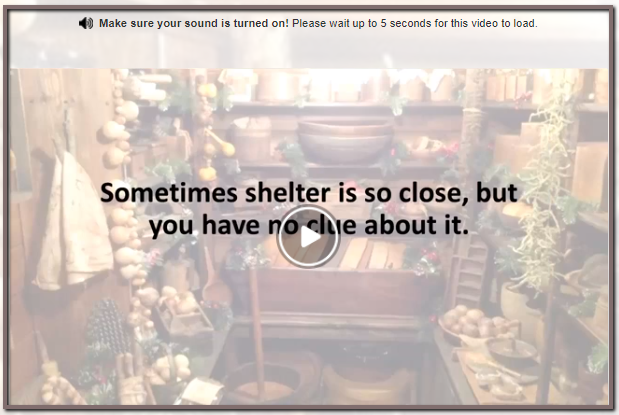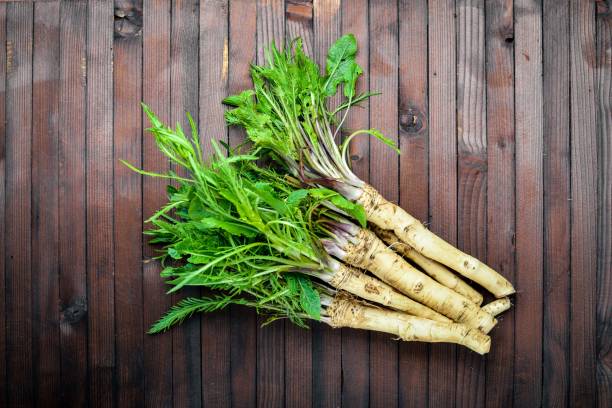Ground horseradish is one of those condiments that people either love or hate intensely. There seems to be no middle ground when it comes to enjoying this spicy treat. If you happen to be a fan of horseradish, you can learn how to grow horseradish in your own backyard.
Horseradish is one of only three perennial garden vegetables, the other two being rhubarb and asparagus. Horseradish is also incredibly easy to grow. As a matter of fact, if you choose to grow horseradish you may find that it grows a bit too well. If not properly maintained or contained, horseradish can quickly spread out of control. But with a little bit of care and planning, you can grow horseradish right where you want it to stay.
Digging horseradish roots and keeping the plants confined to their designated growing area will be the most difficult aspects of the task if you grow horseradish. The plants thrive on neglect and need very little additional care.

Horseradish is grown from pieces of root which are known as sets. You can grow horseradish from root cuttings purchased from a seed catalog, or you can acquire pieces of root from a friend who grows horseradish. Any gardener who grows horseradish will have plenty of root cuttings to share.
Every little bit of root will grow a new horseradish plant, but you’ll achieve larger roots by harvest time if you start with larger root cuttings. Ideally the root sets will be the width of a finger and about a foot long or more.
Pick a spot to grow horseradish where it can grow undisturbed, and make sure your horseradish is not growing right next to other valuable plants. You sure don’t want your horseradish to invade your flowerbeds or berry patch. You can grow horseradish just about anywhere except spots that are heavily shaded or in soil that is constantly soggy.
Plant the roots either in the fall or early spring, after tilling or turning the earth to a depth of at least twelve inches. Remove any stones from the soil as you prepare the planting hole to ensure that your horseradish will grow straight roots. This will also make it easier to harvest the roots later. If you wish, compost may be mixed into the planting hole, but horseradish will grow with or without extra fertilizer.
If you are concerned that the horseradish will encroach upon another plant’s territory, it can also be grown in a large pot. Make sure the pot has ample drainage, and use a fluffy, well-draining potting mix to grow horseradish. Another way to limit horseradish’s wandering habit is to create a barrier around the horseradish. Remove the bottom of a large plastic tub and bury the bottomless tub in the soil surrounding the horseradish.
Plant horseradish roots about 10-18 inches apart, with the crown about 4-6 inches below the soil surface. The crown is the wide, upper end of the root and this is where new top growth will appear. Once planted, water the area well. The plants may be mulched to help keep the soil moist and to discourage weeds.
Once the roots have been planted, you can sit back and relax. You can grow horseradish in abundance without babying the plants. Horseradish is rarely attacked by insects and it is generally free of disease.
Harvesting is the next step in the process if you grow horseradish. Horseradish is harvested by digging up the roots once they have grown large. For the best horseradish flavor, dig the roots after the first frost in the fall. Horseradish roots can also be left in the ground and harvested as needed throughout the winter. To make digging easier, apply a very thick layer of straw mulch over the plants once the foliage has died back after a freeze.
Farmers who grow horseradish commercially plant and harvest their horseradish roots a bit differently, and you can also grow horseradish like this at home. Start by preparing the soil so it is loose and free of stones, then plant the roots horizontally in the planting hole, with the crown elevated slightly. Cover the roots with 6-8 inches of soil, enough to create a raised bed one or two feet wide over the roots.
As the horseradish grows, the diameter of the original root set will increase and many side shoots will develop underground. To grow a horseradish root as large as possible, all but one or two of the leaf shoots should be pinched off from the crown as they develop. This is referred to as suckering.
Lifting is another method commercial growers use to encourage larger horseradish roots. Use the same commercial horizontal planting method, and twice during the growing season you can use a spade to dig through the raised bed and gently lift the crown of the plant.
Lift the crown early in the growing season and again in midsummer, then rebury it. This will break off side roots that form at the crown, forcing more side roots to form at the tail end of the root. Lifting or suckering will encourage the main root to swell more, resulting in the harvest of a one to two pound root.
Commercial growers typically harvest all of the roots each fall, so they don’t have the problem of horseradish escaping into neighboring fields. You can grow horseradish this way too, but if you want to grow horseradish again the following season, you should always save some pieces of side roots that can be replanted. Replant these root pieces right away, or store them in sand over winter and plant them outdoors in the spring.
The horseradish roots can be ground and processed right away after harvesting, or dug horseradish roots can be stored in the refrigerator for months if they are wrapped in plastic to hold in their moisture.
The process of making ground horseradish is quite simple, but it is something that is best done outdoors or in a well ventilated room. Horseradish is powerful stuff and it will make your eyes water as it is ground. Process your homegrown horseradish with a friend so you can get the job done quickly, and also so you can laugh at each other as your eyes water!
Begin by washing the roots well, then peeling them to remove any dark spots. Then use a heavy knife to chop the tough roots into smaller pieces. Fill a food processor bowl or a blender halfway with the chopped horseradish pieces, add just a bit of water and grind the roots to the consistency you like. You may wish to add a half teaspoon of salt or a tablespoon of sugar, depending on your taste.
Once the root has been ground, white vinegar is added. If you prefer a milder horseradish sauce, add a tablespoon of white vinegar immediately after grinding the roots. If you want your horseradish to be as hot as it can be, wait a few minutes before stirring in the vinegar. Spoon the finished horseradish sauce into small jars, seal them tightly and store them in the refrigerator or freezer.

If you grow horseradish at home you can have an endless supply of tasty horseradish sauce for your table or to share with friends who will be very much impressed with your gardening skills.
source : Mike McGroarty



